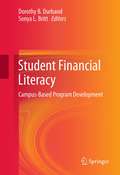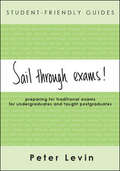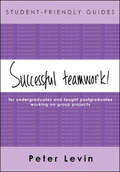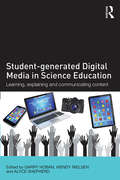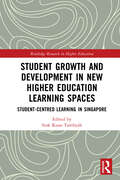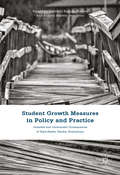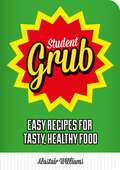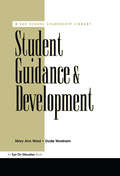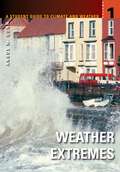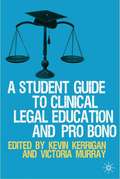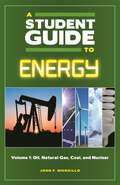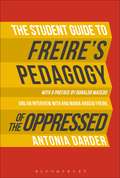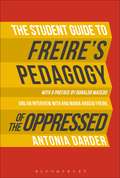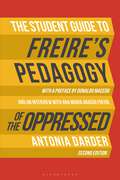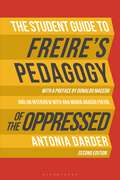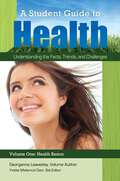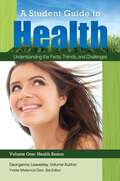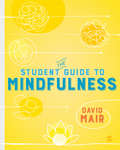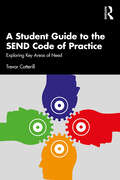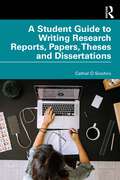- Table View
- List View
Student Financial Literacy: Campus-Based Program Development
by Dorothy B. Durband and Sonya L. BrittCollege students are particularly vulnerable to making poor financial decisions. One method of addressing personal finances and financial stress among students of higher education is through university based financial education programs. Student Financial Literacy: Program Development presents effective strategies to assist in the implementation or the enhancement of a program as a tool to improve students’ educational experience and financial well-being. It presents the key components of financial education programs designed to address the growing concerns associated with high levels of debt and low levels of financial literacy among college students.“Student Financial Literacy: Campus-Based Program Development is packed with financial education and counseling information and guidance. It was very difficult to write this review as I wanted to share ALL the excellent direction this book provides… The editors and contributing authors have developed an excellent resource for not only those interested in developing or enhancing a campus-based financial education program but also for anyone involved in financial education, counseling, and planning.”-Rebecca J. Travnichek, Family Financial Education Specialist, University of Missouri ExtensionJournal of Financial Counseling and Planning
Student-Friendly Guide: Sail through Exams! (UK Higher Education OUP Humanities & Social Sciences Study Skills)
by Peter LevinThis lively, concise and to-the-point guide offers hints and practical sugestions to help you develop good exam-preparation skills and build your confidence, so that you can get results that do justice to the work you've put in. - How to use past exam papers - How to decode difficult-to-understand exam questions - How to structure top-quality answers - How to revise effectively - How to get in the right frame of mind for exams - How to do your best on the day A must for all students preparing for traditional exams!
Student-Friendly Guide: Successful Teamwork (UK Higher Education OUP Humanities & Social Sciences Study Skills)
by Peter LevinThis lively, concise and to-the-point guide offers hints and practical sugestions to help you deal with the issues you face when working on a group project. It helps you to understand what goes on in project groups, to move forward in difficult situation, and to draw valuable lessons from the experience. · How to share out the work · How to transform your group into a team· How to take decision· How to deal with‘free riders’ · How to work constructively with someone you don't like· How to make good use of your experience when applying for jobsA must for every student working on a group project, and especially recommended if you have been put into a group, assigned a project and left alone to get on with it!
Student-generated Digital Media in Science Education: Learning, explaining and communicating content
by Garry Hoban Wendy Nielsen Alyce Shepherd"This timely and innovative book encourages us to ‘flip the classroom’ and empower our students to become content creators. Through creating digital media, they will not only improve their communication skills, but also gain a deeper understanding of core scientific concepts. This book will inspire science academics and science teacher educators to design learning experiences that allow students to take control of their own learning, to generate media that will stimulate them to engage with, learn about, and become effective communicators of science." Professors Susan Jones and Brian F. Yates, Australian Learning and Teaching Council Discipline Scholars for Science "Represents a giant leap forward in our understanding of how digital media can enrich not only the learning of science but also the professional learning of science teachers." Professor Tom Russell, Queen’s University, Ontario, Canada "This excellent edited collection brings together authors at the forefront of promoting media creation in science by children and young people. New media of all kinds are the most culturally significant forms in the lives of learners and the work in this book shows how they can move between home and school and provide new contexts for learning as well as an understanding of key concepts." Dr John Potter, London Knowledge Lab, Dept. of Culture, Communication and Media, University College London, UK Student-generated Digital Media in Science Education supports secondary school teachers, lecturers in universities and teacher educators in improving engagement and understanding in science by helping students unleash their enthusiasm for creating media within the science classroom. Written by pioneers who have been developing their ideas in students’ media making over the last 10 years, it provides a theoretical background, case studies, and a wide range of assignments and assessment tasks designed to address the vital issue of disengagement amongst science learners. It showcases opportunities for learners to use the tools that they already own to design, make and explain science content with five digital media forms that build upon each other— podcasts, digital stories, slowmation, video and blended media. Each chapter provides advice for implementation and evidence of engagement as learners use digital tools to learn science content, develop communication skills, and create science explanations. A student team’s music video animation of the Krebs cycle, a podcast on chemical reactions presented as commentary on a boxing match, a wiki page on an entry in the periodic table of elements, and an animation on vitamin D deficiency among hijab-wearing Muslim women are just some of the imaginative assignments demonstrated. Student-generated Digital Media in Science Education illuminates innovative ways to engage science learners with science content using contemporary digital technologies. It is a must-read text for all educators keen to effectively convey the excitement and wonder of science in the 21st century.
Student-generated Digital Media in Science Education: Learning, explaining and communicating content
by Garry Hoban Wendy Nielsen Alyce Shepherd"This timely and innovative book encourages us to ‘flip the classroom’ and empower our students to become content creators. Through creating digital media, they will not only improve their communication skills, but also gain a deeper understanding of core scientific concepts. This book will inspire science academics and science teacher educators to design learning experiences that allow students to take control of their own learning, to generate media that will stimulate them to engage with, learn about, and become effective communicators of science." Professors Susan Jones and Brian F. Yates, Australian Learning and Teaching Council Discipline Scholars for Science "Represents a giant leap forward in our understanding of how digital media can enrich not only the learning of science but also the professional learning of science teachers." Professor Tom Russell, Queen’s University, Ontario, Canada "This excellent edited collection brings together authors at the forefront of promoting media creation in science by children and young people. New media of all kinds are the most culturally significant forms in the lives of learners and the work in this book shows how they can move between home and school and provide new contexts for learning as well as an understanding of key concepts." Dr John Potter, London Knowledge Lab, Dept. of Culture, Communication and Media, University College London, UK Student-generated Digital Media in Science Education supports secondary school teachers, lecturers in universities and teacher educators in improving engagement and understanding in science by helping students unleash their enthusiasm for creating media within the science classroom. Written by pioneers who have been developing their ideas in students’ media making over the last 10 years, it provides a theoretical background, case studies, and a wide range of assignments and assessment tasks designed to address the vital issue of disengagement amongst science learners. It showcases opportunities for learners to use the tools that they already own to design, make and explain science content with five digital media forms that build upon each other— podcasts, digital stories, slowmation, video and blended media. Each chapter provides advice for implementation and evidence of engagement as learners use digital tools to learn science content, develop communication skills, and create science explanations. A student team’s music video animation of the Krebs cycle, a podcast on chemical reactions presented as commentary on a boxing match, a wiki page on an entry in the periodic table of elements, and an animation on vitamin D deficiency among hijab-wearing Muslim women are just some of the imaginative assignments demonstrated. Student-generated Digital Media in Science Education illuminates innovative ways to engage science learners with science content using contemporary digital technologies. It is a must-read text for all educators keen to effectively convey the excitement and wonder of science in the 21st century.
Student Growth and Development in New Higher Education Learning Spaces: Student-centred Learning in Singapore (Routledge Research in Higher Education)
by Siok Kuan TambyahLearning spaces are an increasing area of debate in higher education studies, as universities attempt to develop holistic forms of education that connect epistemological areas. Focusing on faculty-student collaborative learning in residential colleges in Singapore, this book carefully examines how we can enable students to grow and develop, not just as workers for the global marketplace but also as unique individuals. Showcasing the diversity of programs and initiatives that contribute to student learning outcomes, the volume draws upon the real-world experiences of educators and students. Contributors examine the benefits and challenges of crafting and implementing innovative programs and activities focused on the technologies of learning, interdisciplinary thinking, experiential learning, community engagement and authenticity. Students, working with one another, their teachers and community partners, also play a pivotal role in co-creating their learning journeys. The chapter authors provide their critical reflections on how the experiences and lessons learnt may apply to other learning spaces in higher education (including online and blended spaces). This edited volume will be relevant to any educator, researcher or student interested in creative learning spaces, and innovative programmes and activities that bring together students, educators and community partners.
Student Growth and Development in New Higher Education Learning Spaces: Student-centred Learning in Singapore (Routledge Research in Higher Education)
by Siok Kuan TambyahLearning spaces are an increasing area of debate in higher education studies, as universities attempt to develop holistic forms of education that connect epistemological areas. Focusing on faculty-student collaborative learning in residential colleges in Singapore, this book carefully examines how we can enable students to grow and develop, not just as workers for the global marketplace but also as unique individuals. Showcasing the diversity of programs and initiatives that contribute to student learning outcomes, the volume draws upon the real-world experiences of educators and students. Contributors examine the benefits and challenges of crafting and implementing innovative programs and activities focused on the technologies of learning, interdisciplinary thinking, experiential learning, community engagement and authenticity. Students, working with one another, their teachers and community partners, also play a pivotal role in co-creating their learning journeys. The chapter authors provide their critical reflections on how the experiences and lessons learnt may apply to other learning spaces in higher education (including online and blended spaces). This edited volume will be relevant to any educator, researcher or student interested in creative learning spaces, and innovative programmes and activities that bring together students, educators and community partners.
Student Growth Measures in Policy and Practice: Intended and Unintended Consequences of High-Stakes Teacher Evaluations
by Kimberly Kappler Hewitt Audrey Amrein-BeardsleyThis book examines the intersection of policy and practice in the use of student growth measures (SGMs) for high-stakes purposes as per such educator evaluation systems. The book also focuses on examinations of educators’ perceptions of and reactions to the use of SGMs; ethical implications pertaining to the use of SGMs; contextual challenges when implementing SGMs; and legal implications of SGM use. The use of student test score data has been the cornerstone of the recent transfiguration of educator evaluation systems in forty-two states and the District of Columbia. Three leading voices on SGMs—Sean Corcoran, Henry Braun, and David Berliner—also serve as section and concluding commentators.
Student Grub: Easy Recipes For Tasty, Healthy Food
by Alastair WilliamsClear away the clutter of takeaway tins with this fresh edition of the Student Grub cookbook – the original (and best!) cookbook for university newbies. This easy-to-follow guide contains everything from basic recipes to world cuisine – from conjuring up a post-pub snack to impressing your date with a three-course culinary spectacular.
Student Guidance & Development
by Dode Worsham Mary Ann WardThis book provides information about best practices in guidance and counseling. It provides examples of innovative programs which meet students' personal needs, such as school-wide discipline programs, peer mediation, student activities. etc.
Student Guidance & Development
by Dode Worsham Mary Ann WardThis book provides information about best practices in guidance and counseling. It provides examples of innovative programs which meet students' personal needs, such as school-wide discipline programs, peer mediation, student activities. etc.
A Student Guide to Climate and Weather [5 volumes]: [5 volumes]
by Angus M. GunnA comprehensive guide to the weather, climate, and their impact on human life.This comprehensive reference explains in clear terms what we know about weather, from the everyday to the extreme. A Student Guide to Climate and Weather introduces students and other interested readers to the dynamic work of meteorologists and climatologists, specifically their efforts to mitigate the impact of weather events and climate change on people and the environment.The five separate volumes of A Student Guide to Climate and Weather focus on weather extremes; air masses and weather patterns; cyclones, hurricanes, and tornadoes; climate change; and the Earth and the sun. Each volume combines a wealth of scientific data, dramatic historical events, and the latest ideas and methods from the worlds of meteorology and climatology. What did we learn from the Dust Bowl? What are the consequences of Arctic melting? How do we protect cities near oceans from rising sea levels? These and other crucial questions are explored in this cornerstone reference.
A Student Guide To Clinical Legal Education And Pro Bono (PDF)
by Kevin Kerrigan Victoria MurrayClinical legal education – the participation by law students in the giving of legal advice and representation to actual clients – is playing an increasingly important role within UK law schools. Pro bono - the provision of free legal advice or representation for those who may otherwise have no access to justice - is a vital part of the legal profession's commitment to the rule of law. This book is written by members of staff at Northumbria University's ground-breaking legal clinic, the Student Law Office. The authors, all of whom are qualified solicitors, have applied their long experience of clinical legal education into providing an authoritative and practical guide to all aspects of the subject, from valuable advice on establishing a law clinic and the professional and ethical issues involved, to practical skills such as interviewing, drafting and advocacy. The text includes detailed lists of further reading and a series of practical activities at the end of each chapter. A companion website featuring useful supplementary material can be found at www.palgrave.com/law/lawclinic
A Student Guide to Energy [5 volumes]: [5 volumes]
by John F. MongilloThis multivolume resource is an excellent research tool for developing a working knowledge of basic energy concepts and topics.With energy issues so much in the news, it is important that students get a clear understanding of how energy is produced and how it affects virtually every aspect of our lives. The multivolume set A Student Guide to Energy does just that, with an accessible introduction to the basic concepts and key topics concerning nonrenewable energy sources, future renewable energy programs, and the importance of achieving a sustainable energy program for future generations.A Student Guide to Energy is divided into five separate volumes. Volume 1 highlights our present dependence on nonrenewable energy sources—oil, gas, coal, and nuclear power. Volumes 2, 3, and 4 look at the renewable energy sources that will play a vital role in our future, including solar energy, hydrogen fuel cells, wind and water power, and geothermal energy. The concluding volume focuses on efforts to develop a global sustainable energy system that encompasses energy efficiency, conservation, and a healthy, cleaner environment.
The Student Guide to Freire's 'Pedagogy of the Oppressed'
by Antonia DarderThis book serves as an important companion to Freire's seminal work, providing powerful insights into both a philosophically sound and politically inspired understanding of Freire's book, supporting application of his pedagogy in enacting emancipatory educational programs in the world today. Antonia Darder closely examines Freire's ideas as they are articulated in Pedagogy of the Oppressed, beginning with a historical discussion of Freire's life and a systematic discussion of the central philosophical traditions that informed his revolutionary ideas. She engages and explores Freire's fundamental themes and ideas, including the issues of humanization, the teacher/student relationship, reflection, dialogue, praxis, and his larger emancipatory vision. Questions are included throughout Chapter 3, Reading the Text Chapter-by-Chapter, to enable greater discussion of, and engagement with, the text itself. The book includes an incisive interview with Freire's widow, Ana Maria Araujo Freire. The bibliography offers invaluable support to those looking to read and study other works by Paulo Freire.
The Student Guide to Freire's 'Pedagogy of the Oppressed'
by Antonia DarderThis book serves as an important companion to Freire's seminal work, providing powerful insights into both a philosophically sound and politically inspired understanding of Freire's book, supporting application of his pedagogy in enacting emancipatory educational programs in the world today. Antonia Darder closely examines Freire's ideas as they are articulated in Pedagogy of the Oppressed, beginning with a historical discussion of Freire's life and a systematic discussion of the central philosophical traditions that informed his revolutionary ideas. She engages and explores Freire's fundamental themes and ideas, including the issues of humanization, the teacher/student relationship, reflection, dialogue, praxis, and his larger emancipatory vision. Questions are included throughout Chapter 3, Reading the Text Chapter-by-Chapter, to enable greater discussion of, and engagement with, the text itself. The book includes an incisive interview with Freire's widow, Ana Maria Araujo Freire. The bibliography offers invaluable support to those looking to read and study other works by Paulo Freire.
The Student Guide to Freire's 'Pedagogy of the Oppressed'
by Professor Antonia DarderNow in its 2nd edition, this book serves as companion to Freire's seminal work, supporting the application of his pedagogy in enacting emancipatory educational programs in the world today. The new edition includes a new chapter called Teaching Pedagogy of the Oppressed with additional dialogue questions and activities designed to support students and instructors. It also includes an updated Bibliography and further reading list. Antonia Darder closely examines Freire's ideas as they are articulated in Pedagogy of the Oppressed, beginning with a historical discussion of his life and a systematic discussion of the central philosophical traditions that informed his revolutionary ideas. Darder explores Freire's fundamental themes and ideas, including issues of humanization, teacher/student relationship, reflection, dialogue, praxis, and his larger emancipatory vision. The book also includes a chapter-by-chapter close reading of the text with sample questions to prompt discussion and engagement with Freire's ideas, as well as a new interview with Freire's widow, Ana Maria Araújo Freire, and a preface by Donaldo Macedo.
The Student Guide to Freire's 'Pedagogy of the Oppressed'
by Professor Antonia DarderNow in its 2nd edition, this book serves as companion to Freire's seminal work, supporting the application of his pedagogy in enacting emancipatory educational programs in the world today. The new edition includes a new chapter called Teaching Pedagogy of the Oppressed with additional dialogue questions and activities designed to support students and instructors. It also includes an updated Bibliography and further reading list. Antonia Darder closely examines Freire's ideas as they are articulated in Pedagogy of the Oppressed, beginning with a historical discussion of his life and a systematic discussion of the central philosophical traditions that informed his revolutionary ideas. Darder explores Freire's fundamental themes and ideas, including issues of humanization, teacher/student relationship, reflection, dialogue, praxis, and his larger emancipatory vision. The book also includes a chapter-by-chapter close reading of the text with sample questions to prompt discussion and engagement with Freire's ideas, as well as a new interview with Freire's widow, Ana Maria Araújo Freire, and a preface by Donaldo Macedo.
A Student Guide to Health [5 volumes]: Understanding the Facts, Trends, and Challenges [5 volumes]
by Georganna Leavesley Alice C. Richer Nancy A. Piotrowski Yvette Malamud OzerThis comprehensive, five-volume reference set is aligned with the National Health Education Standards, containing up-to-date, scientifically based information on a variety of health and wellness topics relevant to high school students.A Student Guide to Health: Understanding the Facts, Trends, and Challenges provides straightforward, factual, and accessible information about a multitude of health issues. It is an essential reference set that provides high school students, teachers, and administrators with a comprehensive health and wellness education resource that aligns with National Health Education Standards and common health curriculum. This expansive five-volume set is ideal for students' research projects; highly useful as a resource for community college and public library patrons, librarians, teens, and parents; and is a suitable supplement to any health education curriculum.Each chapter includes up-to-date, evidence-based information that provokes further examination and encourages critical thinking to evaluate the validity of information encountered about health and wellness topics. Each chapter provides an abundance of references and lists of resources for further information, including books, articles, websites, organizations, and hotlines. Special attention is paid to social trends that affect youth health and wellness, such as bullying, eating disorders, steroid abuse, sexting, and the peer pressure associated with drug use and abuse.
A Student Guide to Health [5 volumes]: Understanding the Facts, Trends, and Challenges [5 volumes]
This comprehensive, five-volume reference set is aligned with the National Health Education Standards, containing up-to-date, scientifically based information on a variety of health and wellness topics relevant to high school students.A Student Guide to Health: Understanding the Facts, Trends, and Challenges provides straightforward, factual, and accessible information about a multitude of health issues. It is an essential reference set that provides high school students, teachers, and administrators with a comprehensive health and wellness education resource that aligns with National Health Education Standards and common health curriculum. This expansive five-volume set is ideal for students' research projects; highly useful as a resource for community college and public library patrons, librarians, teens, and parents; and is a suitable supplement to any health education curriculum.Each chapter includes up-to-date, evidence-based information that provokes further examination and encourages critical thinking to evaluate the validity of information encountered about health and wellness topics. Each chapter provides an abundance of references and lists of resources for further information, including books, articles, websites, organizations, and hotlines. Special attention is paid to social trends that affect youth health and wellness, such as bullying, eating disorders, steroid abuse, sexting, and the peer pressure associated with drug use and abuse.
The Student Guide to Mindfulness (SAGE Study Skills Series)
by David MairDo you want to: Learn how to embed mindfulness in your everyday life? Understand how to manage feelings of anxiety or depression? Find a healthy balance between course work, job and social life? Face the future with a positive attitude? More than ever students are reporting high levels of stress, depression and loneliness while at university – so looking after your mental wellbeing is just as important as academic preparation. This book provides grounded guidance on how mindfulness can be used to cope with the main sources of anxiety while you are completing your studies, so you can find balance and make the most of student life. Combined with practical and recorded mindfulness exercises, learn how to master techniques and tools to reconnect with the present and yourself, and approach life at uni in a stress-free way.
The Student Guide to Mindfulness (SAGE Study Skills Series)
by David MairDo you want to: Learn how to embed mindfulness in your everyday life? Understand how to manage feelings of anxiety or depression? Find a healthy balance between course work, job and social life? Face the future with a positive attitude? More than ever students are reporting high levels of stress, depression and loneliness while at university – so looking after your mental wellbeing is just as important as academic preparation. This book provides grounded guidance on how mindfulness can be used to cope with the main sources of anxiety while you are completing your studies, so you can find balance and make the most of student life. Combined with practical and recorded mindfulness exercises, learn how to master techniques and tools to reconnect with the present and yourself, and approach life at uni in a stress-free way.
A Student Guide to the SEND Code of Practice: Exploring Key Areas of Need
by Trevor CotterillIn this essential textbook for students, Trevor Cotterill delves into the four broad areas of need identified in the SEND Code of Practice (2015), providing a spotlight on current research into a range of identified difficulties as well as outlining the appropriate pedagogical approaches required to support these needs in children and young people. Closely mirroring the SEND Code of Practice (2015), each distinct area of need associated with cognition and learning, communication and interaction, physical and sensory issues and social, emotional and mental health difficulties features essential overviews of research and current thinking within each area. Supported with case studies, learning objectives and reflection points, this text includes discussions on autistic spectrum disorders, profound and multiple learning difficulties, ADHD, mental health, physical and sensory difficulties and adverse childhood experiences as they relate to the SEND Code of Practice (2015). Fully endorsed by evidence-based research involving children, young people, adults and their families, this text encourages students to understand that SEND is a complex area and provides opportunities to reflect on previous experience, harnessing them with knowledge for future practice. Concise yet rigorous in its explanations and coupled with signposted activities and suggestions for further reading throughout, A Student Guide to the SEND Code of Practice will be invaluable to undergraduate students undertaking a programme of study incorporating special educational needs and disability as a single or joint honours.
A Student Guide to the SEND Code of Practice: Exploring Key Areas of Need
by Trevor CotterillIn this essential textbook for students, Trevor Cotterill delves into the four broad areas of need identified in the SEND Code of Practice (2015), providing a spotlight on current research into a range of identified difficulties as well as outlining the appropriate pedagogical approaches required to support these needs in children and young people. Closely mirroring the SEND Code of Practice (2015), each distinct area of need associated with cognition and learning, communication and interaction, physical and sensory issues and social, emotional and mental health difficulties features essential overviews of research and current thinking within each area. Supported with case studies, learning objectives and reflection points, this text includes discussions on autistic spectrum disorders, profound and multiple learning difficulties, ADHD, mental health, physical and sensory difficulties and adverse childhood experiences as they relate to the SEND Code of Practice (2015). Fully endorsed by evidence-based research involving children, young people, adults and their families, this text encourages students to understand that SEND is a complex area and provides opportunities to reflect on previous experience, harnessing them with knowledge for future practice. Concise yet rigorous in its explanations and coupled with signposted activities and suggestions for further reading throughout, A Student Guide to the SEND Code of Practice will be invaluable to undergraduate students undertaking a programme of study incorporating special educational needs and disability as a single or joint honours.
A Student Guide to Writing Research Reports, Papers, Theses and Dissertations
by Cathal Ó SiochrúThis useful guide for students combines all the guidance, advice and key tips needed to write successful research reports, theses or dissertations, exploring, in detail, each of the elements involved in writing an academic paper. The book will guide you through all the key sections of a report including the introduction, literature review, method, results, discussion and more. Each chapter contains instructions and advice aimed at three different levels of report writing experience – ‘The basics’ covers the basic purpose and structure of each section as well as the most common mistakes, ‘Refinements’ helps you to develop your report writing skills beyond the basics, adding polish and depth, and ‘Advanced’ offers advice and insight into the most complex issues in report writing. In addition to the guidance, there are examples to show you the principles of report writing in action and exercises which allow you to test your understanding as you learn. An essential reference for any student writing an academic paper, A Student Guide to Writing Research Reports, Papers, Theses and Dissertations is the ideal resource to be used as part of your independent study or when working with a supervisor.
